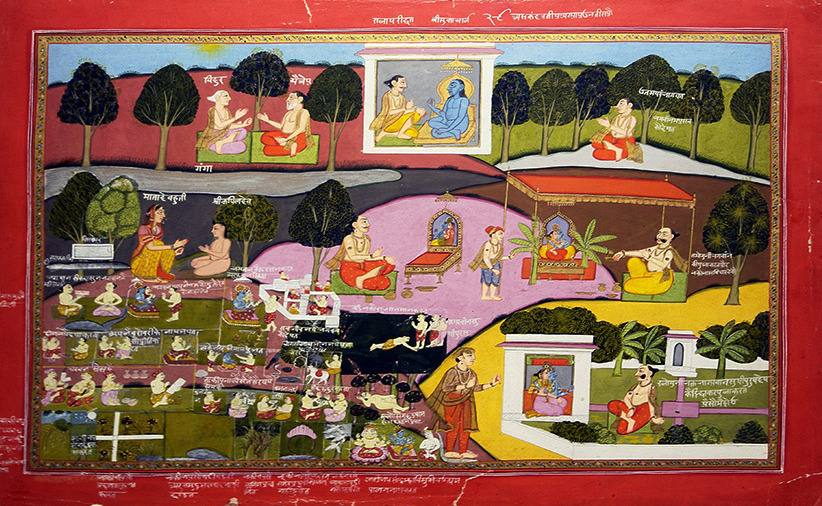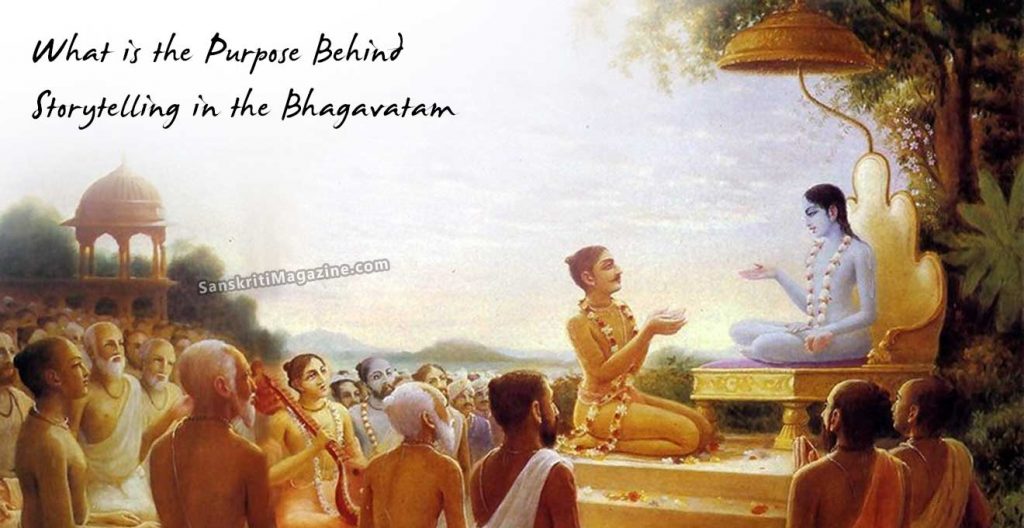Question: I heard that Sukadeva Gosvami was Krsna’s parrot in his last life, and in this life he was a brahman-realized person. How is one to understand this, if he’s an eternal associate of the Lord? Is this a lila or something else?
Answer: There are various types of stories related to Sukadeva in shastra, and each is given to illustrate specific points. For example, there is also a story that Sukadeva got married and had children. The important thing is not the story but the message behind it. Vyasa is not a story teller but an educator, and stories are the best way to educate. This is also accepted by modern pedagogues.
Stories are told according to the needs of the audience. Thus, there may be variations in the stories. Moreover, history is not linear but cyclic. This is difficult for the modern mind to grasp. There have been many Sukas, just as there have been many Vyasas. So do not get confused by the identity of names. Two stories can be about two different Sukas, from two different cycles.
Try to understand the essence of the philosophy and do not get lost in the stories. These stories are not given just for their own sake, they are there to explain Vedic philosophy. Like when you are teaching the alphabet to a child, you make a picture of an apple and write a big “A” next to it. The intent is to teach “A”, which has nothing to do with the apple, except that it helps in teaching “A”.
Whether Sukadeva Gosvami really existed or not, and whether he was a parrot or a human, is not so important. The point is to grasp what is being explained, e.g. dharmah projjhita-kaitavah (to reject all materially motivated or cheating religion), and stories are a great means of preserving the teaching. They are also good entertainment, for example on parikrama. But we must make a distinction between stories of Krsna and of other personalities. Stories of Krsna and His devotees have spiritual value apart from the message behind them. These stories purify the heart even if one does not understand the message conveyed in them.
So for example, pure bhakti can’t be performed unless one becomes free from the propensity to cheat. Among various types of cheating, one of the worst is the desire for liberation. Unless one becomes completely free from the desire for liberation, one will not perform pure bhakti, because mukti and bhakti are absolutely antagonistic to each other. One who wants to attain mukti has no interest in bhakti. Inherently, the desire for mukti means, “The world is a place of misery, it is not even real. I will renounce everything. Let the whole world burn to ashes, I don’t care.” Such a person is interested only in his own selfish desire to be free from suffering and nothing else. The desire to serve anyone, even God, cannot take hold in such a mind, thus this conception has to be completely uprooted from a person’s heart before love of God can be achieved.
The story of Sukadeva Gosvami is given specifically to make this point. Sukadeva was self-realized from his very birth, nobody could ever be more realized than he was. He was so absorbed in Brahman that he did not even know the difference between male and female. But later, the same person heard a few verses from the Bhagavatam describing the beauty and compassion of Krsna, and he became mesmerized by these verses. Sukadeva—who was so renounced that he left home just after birth, not even caring that his father was piteously calling after him to please come back—returned home to study the Bhagavatam from that same father. He, who would not stay in one place for more than a few minutes, lived at his father’s ashram and studied the whole Bhagavatam encompassing twelve Cantos. This means bhakti is superior to mukti. Mukti is so unattractive in comparison to bhakti that even such a great, highly renounced person, renounced mukti itself to achieve bhakti. When Sukadeva Gosvami became a devotee, he even renounced vairagya, renunciation. What can be higher renunciation than that? Who will renounce such a position? And then he became a follower of bhakti-marga, the devotional path. That is the import of the story of Sukadeva in the Bhagavatam. Vyasa cleverly refutes Advaitavada and establishes bhakti as supreme by telling the story of Suka at the very beginning of the Bhagavatam.

Unless bhakti is established as superior and mukti as inferior, one will not take interest in it. The Bhagavatam is basically there to delineate this fact. This is the essence of the dialog that took place between Narada and Vyasa, when Vyasa was feeling incomplete even after having written Vedanta Sutra and Mahabharata. Sri Narada pointed out to him that Vyasa had not clearly explained uttama-bhakti. So Vyasadeva began Bhagavatam with the story of Suka. He explained that he had a son, Sukadeva, and that son was born only after remaining in his mother’s womb for sixteen years. If you think about this, you do not have to go far before you get into trouble. How is it possible that Sukadeva Gosvami stayed in the womb for sixteen years? It is said that as soon as he took birth, he walked away. Does it mean that he came out as a grown-up man or did he grow immediately after taking birth? And how could he have taken birth? It’s all very problematic if you’re looking at the superficial story. So then what is the need of showing all these story elements? That is because most people are interested in stories, and stories stick in the mind. People pay attention to and remember interesting stories. Previously many people could not read and write, and even for those who could, books were very difficult to produce and hard to acquire. So to create interest and be easily remembered, we are given, “A” for apple.
But the point is not in the story at all. If you try to investigate the story itself, you’ll end up nowhere. There are so many types of Sukadeva Gosvamis. When you read Mahabharata, Sukadeva Gosvami is married and has children. And there is also Chaya-Sukadeva, shadow-Sukadeva. But that is not the point. The point is the purport behind the story. Bhagavatam wants to establish dharmah projjhita-kaitava, therefore different stories are brought in to explain the principle.
For another example, take the story of the Four Kumaras. Like Sukadeva, they were also Brahman-realized. They were so elevated, they even went to Vaikuntha. Then once they were there, they become angry—anger and pride overtook them, even there. In contrast, the gatekeepers Jaya and Vijaya kept calm and maintained a humble demeanor although they were not at mistake in stopping the Kumaras from entering, because the Kumaras were not dressed properly. If you have to go to God, you have to dress properly. That means if you have no spiritual vasanas, you cannot reach God.
This story was to show that even such renounced people cannot become free from their material vasanas. Only bhakti makes one completely pure and cleans the heart of all impurities. The Kumaras were absorbed in Brahman, and like Sukadeva they also went naked. They were so renounced, they did not even wear clothes, so where is the possibility of them becoming angry? The story is there basically to defeat all these Mayavada conceptions and similarly the path of yoga. Another story to the same end was that of Saubhari Muni. He meditated for a long time inside the Yamuna River, and yet became interested in married life. He was like a skeleton from performing austeries, but sex desire did not leave him. On the other hand we read stories of devotees like Sri Haridasa Thakura, who could not be allured by a young woman or even by Mayadevi personified.
All these stories are there specifically to show the greatness of bhakti over all other paths. The point is not in the telling of a story, but in what the story is trying to tell us.
So, the stories of the Kumaras and Sukadeva expose the flaw in the path of jnana. They were the most advanced followers of jnana-marga, but when introduced to bhakti, they threw aside their desires for mukti and took up bhakti for Krsna. The whole purpose of stories such as Sukadeva’s is to show how devotion is free from all materialistic motives and selfishness, which are all cheating. Unless one comes to the platform of pure devotion, one remains impure, because he still has the cheating propensity deep in his heart. By running after the superficial details of his story, its true point will be lost and we will have missed the benefit for which it was told in the first place.
Source: jiva.org











